
Index:
UPDATED ✅ Do you want to know the history of how Atari was created and how it evolved until today? ⭐ ENTER HERE ⭐ and Learn Everything! FROM ZERO! ⭐
late 1975sales of devices that allowed consumers play pong in home televisions were booming. At Atari Inc.which had first introduced Pong as an arcade game and made one of the most popular home versions of Pong, engineers began looking for the next arcade game to get into the hands of consumers, anticipating that people would get tired of two shovels and a ball.
they saw the Jet Fighter and the Tank, but instead of designing a custom chip for each game, as was done with Pong, they planned a system that would allow playing both games, four-player Pong if anyone was interested, and possibly some other yet unknown games. The system was to be based on a microprocessor.
In a few months, Atari designers in Grass Valley, Californiahad built a working prototype, and over the next year, designers in Grass Valley and Sunnyvale, California, perfected what would become the Atari Video Computer System (VCS). It went on sale in 1977 and, six years later, it is one of the most successful microprocessor-based products in history, with more than 12 million units sold at about $140 each.
Atari 2600, the beginnings
Success did not come without problems. The production problems in the first two years caused Atari losses estimated at about 25 million dollars. But once these problems were resolved and enough software was developed, the SCV took off.
Today he is popular, not because he does an admirable job of playing Jet Fighter and Tankbut because its flexible design also allows you to play chess and baseball, as well as Space Invaders, Pac-Man and many of the other arcade games that have been invented since the VCS was released. There are currently more than 200 different cartridges on the market (read-only memories (ROM) containing the VCS software), manufactured by some 40 companies, and new games are constantly being developed.
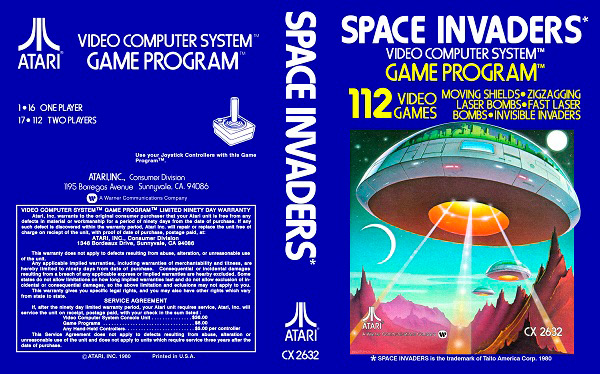
It is estimated that 120 million cartridges have been sold at prices ranging from $12 to $35, and the demand is such that, in addition to buying more 6502 microcomputers than anyone else in the world, Atari’s purchases of ROMs for its various divisions are greater than those of all other companies of the world together.
Atari and other video game companies had been making microprocessor-based arcade games for a long time before the Atari Video Computer System (VCS), but the cost of the processors available at the time ($100 or more each) made the idea of a microprocessor-based consumer product unfeasible. then it came chuck peddle and the 6502.
Mr. Peddle, who had left Motorola for MOS Technology after designing the MC6800 microprocessor, appeared on wescon (the annual West Coast electronics fair) in September 1975, offering to sell his new microprocessor by the barrel at $8 each.
“Of course, no one knew he only had one barrel to his name.”
Remember Steve Mayerco-founder of Cyan Engineering, Atari’s private consulting firm in Grass Valley, and current senior vice president of R&D at Atari.
Mayer and Ron Milner, his colleague at Cyan, went to see Mr. Peddle at Wescon and found that the 6502 precisely matched the minimum specs they had long established for a programmable video game design. The three of them went to the back of the MOS Technology suite, Mr. Mayer recalls, and within an hour the deal was done. This started a revolution in home video games.
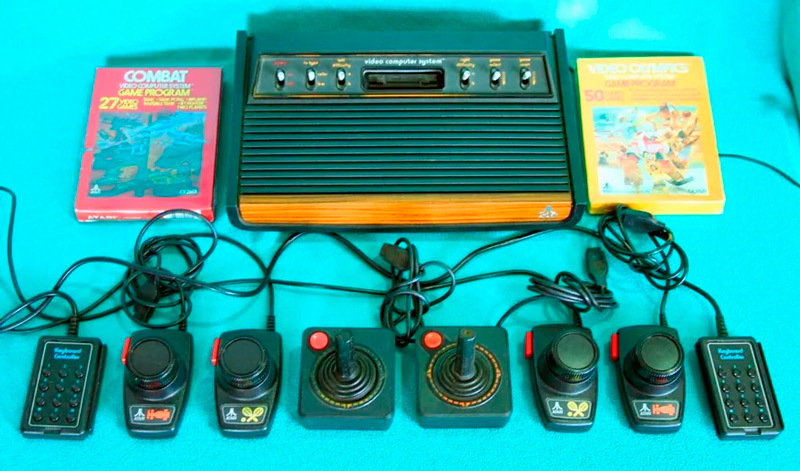
Trying to survive
No one saw him like that at the time. “We were just trying to surviveMayer told Spectrum. Atari had entered the home video market with a one-chip version of its arcade game Pong, and was developing other home video games, But each was based on a single custom chip that took a year or more and more than $100,000 to develop; by the time an arcade game hit the market, consumers would have forgotten about it. A programmable home video game seemed like a desirable alternative.
The key to the design was simplicity: make software do as much of the work as possible, so hardware could be cheaper (silicon was very expensive at the time). The microprocessor was synchronized with the scanning speed of the television and created the screen one or two lines at a time. This synchronization greatly reduces the memory requirements of the television interface, but the processor must continually update the interface registers to get any display.
The program that feeds information to the video chip (named Stella, after its designer’s bicycle) is known as kernel. To further reduce memory requirements, Mayer and Milner decided to display the background of the screen in relatively low resolution and moving objects in higher resolution: low resolution playing field and high resolution players. They also removed any provision for vertical sync and gave that task to the programmer.
A vcs-kernel must count the number of lines displayed on the TV screen and it should finish showing a single frame at exactly the same time (15.24 milliseconds) it takes for the TV’s electron gun to make a single sweep from top to bottom.
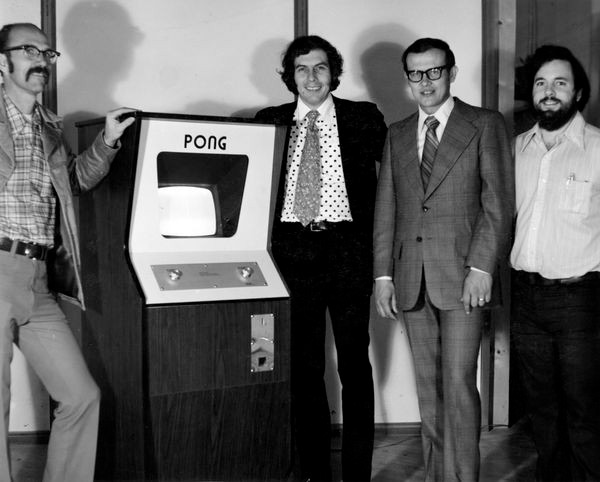
Two prototypes of the Stella were built: a working prototype built by Mr. Milner to prove the concept, and a gate-level prototype built by Joe Decuirwhich was hired by Cyan in late 1975. The gate-level prototype was designed to closely mimic the intended final chip, using circuit design techniques specific to MOS ICs.
A critical MOS-dependent feature was the use of a special counter (called a polynomial counter or pseudorandom shift register) instead of a true binary counter to determine the positions of objects on the screen. A polynomial counter it occupies a quarter of the silicon area of an equivalent binary counter, but, unlike a binary counter, it does not count in any simple order. Therefore, a programmer cannot compute the screen position of an object and load it into the position counter.
The Stella’s original prototype only had one signal for the position counter: a reset that triggered the immediate display of an object. Decuir and Jay Miner, who designed the production version of the Stella chip, used this same concept in their design.
So, To display an object at a certain position on the screen, it is necessary for the programmer to count the number of clock cycles that a certain set of instructions takes.calculate how far from the screen finds the electron beam after the instructions have been executed and act accordingly. Once an object’s position counter is reset to zero at the appropriate point, it continues to display the object at that point on successive lines.
To move the objects, the prototype blocked four clock pulses from the position counters during the vertical blanking interval; a programmer could then add ticks to move an object left or right; four pulses had to be added to keep the object in the same place.
The Mr. Miner added a set of movement records, that automatically add or subtract pulses when the microprocessor sends a signal called H motion. The H-Move it can be sent during the vertical blanking interval, or during the horizontal blanking interval at the beginning of each line.
“This seemed pretty innocuous“, said Larry Kaplanthe first software designer hired to develop games for the Stella project.
“But I soon discovered that it was possible to reposition the player objects during a screen (one frame of the TV image), although that was not in the design.“

So Mr. Kaplan designed Air-Sea Battle, which has horizontal bands of player objects, a technique used in countless VCS games, such as Space Invaders, Freeway, Asteroids and Football. “Without that single H-move, the SCV would have died quickly five years ago.“, Mr. Kaplan saidnow vice president of product development at Atari.
H-move and a feature that allowed two or three copies of an object to be placed on the screen allowed another VCS programmer, Rick Mauerdesign a home version of the arcade hit, space invaders. That game hit arcades in 1979, when the VCS was going downhill after losing money in 1977 and 1978.
“The VCS wasn’t doing very well (there were only a few million on the market, and it seemed to be dying) until Space Invaders came out, and bam! explodedMr. Kaplan said. Space Invaders was the most popular game in arcadesand the VCS, with its rows of six objects on the screen (two player-objects, copied three times each) could recreate it at home.
Another hardware feature, which actually cost a fair amount of silicon, was vertical delay, or VDEL. The VCS writes two TV lines at once, explained Mr. Miner, but moving objects in two lines between frames causes jerky movements. A way had to be found to move the objects only one line, and that way was the VDEL. Two registers are used to hold graphical information for each player object, and VDEL selects which register to display on screen.
The sequence of events is as follows: information sent to screen registers for a player object is loaded into its parent register; when information is written to the other player object, the contents of the primary register for the first object are automatically duplicated in its secondary register; if the information for each player object is written every two scan lines, the secondary record selected by VDEL will display the same shape as the primary record, but one line later. This technique is now used to load different information into the parent and child registers of each player objectresulting in single line resolution and other unwanted bonuses.
addition to power determine the shape of an object, programmers can also determine its color and luminance. The decision to use both color and luminance registers probably would not have been made were it not for the simplicity of color control. Television color is determined by the phase difference between the color signal and a reference signal, or color burst, that is transmitted at the beginning of each line. The VCS phase shifter it is nothing more than a delay line tapped at appropriate intervals, so it takes up quite a bit of space on the chip.
An example of extensive color manipulation is a subroutine developed by the Mr. Decuir to prevent game patterns from being burned into the TV screen if the Atari Video Computer System (VCS) is left unattended. The routine, which ran through all possible combinations of color and luminance, used only a dozen bytesa huge advantage over early game cartridges, which only contained 2 kilobytes of ROM. “In the 2K, you barely have room to brush your teethsaid Mr. Decuir.
A similar variety of effects was produced with a minimum of space on the sound generator chip; it contains just a few polynomial dividers and counters that can be interconnected in various ways under program control. A 5-bit polynomial counter, Mr. Decuir noted, produces a low, growling sound (used in Tank), and a 9-bit counter produces a hissing sound (used in Jet Fighter). The rest of the sounds that the programmers have made the VCS produce are essentially free, and have been extensive: Mr. Mayer said that he has even heard the VCS play the words “ET phone home“
exploit the hardware
Since the VCS (Atari Video Computer System) hardware does so little by itself, the programmer has to bear a heavy load. But although the programming is arduous, few walls stop the creativity of the software.
“Write the kernels that make up the game programs, It’s like solving acrostic puzzles with tons of possibilities. There’s a certain kind of programmer who can deal with microcode like that. If it were easier to program, we wouldn’t have these programmers, because they would get bored. The VCS is an absolute challenge” – Mr. Mayer.
“Another way of saying it is that to deal with a VCS you have to unlearn all the good programming practices you have learned.said Mr. Mauer, who designed space invaders.
Bob Whiteheadprincipal designer and co-founder of Activision Inc. in Mountain View, California, may be the most innovative VCS designer – credited with the most firsts using a new trick. But he is philosophical about his innovations. “A computer is a computer“, he says, “and it only works one way. If something new comes up, it’s nice, but no more than that, because it’s something that the computer has always been able to do; you just haven’t figured it out before. It’s like finding a penny under the sofa: It’s always been there, but it’s nice to find out.”
Once a hack is discovered and implemented in a game, it becomes obvious to experienced game programmers. Atari Video Computer System (VCS), Mr. Whitehead noted, and soon the trick is copied in other games. Less experienced programmers consult a list of programs or pick up tricks by word of mouth.
Today, however, designers estimate that the hardware has been 70/80% exploited. “More and more nice things are coming out,” said Mr. Whitehead, “but every time we discover something new, we think it’s the last thing.”
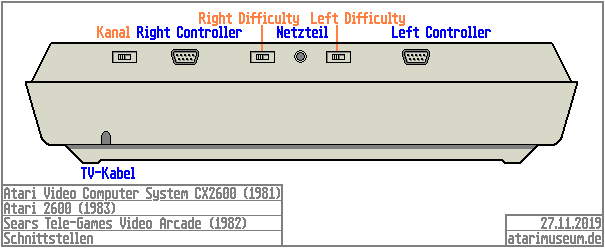
Change screens “on the fly”
The first trick came about when Mr. Whitehead designed Blackjack, and is now used in almost every game on the VCS. It is the ability to rewrite player objects “on the fly”. Since the microprocessor must feed information each line to the “Stella” chip to make a display, it can change the information even during one line to change the appearance of objects.
hardware it can produce multiple copies of a spawner item (a feature added so biplane groups could fight each other) and Mr. Whitehead discovered that he could change the displayed spawner item between copies. Instead of putting three copies of the same object, the VCS then displays three different objects: three different cards in the case of Blackjack.
Objects can also be rewritten as they are repositioned vertically, so the different rows of aliens in Space Invaders look different. This ability was taken to the extreme in highway from Activision, with 10 lanes of traffic and different cars and trucks all over the screen. It was also used very successfully in asteroidsin which the rocks that seem to shoot across the screen are in two rows, half moving up and half moving down.
But an early limitation of rewriting player objects on the fly was that the copied objects had to be moved together, because the Atari Video Computer System (VCS) it only produces multiple images at fixed distances. A hack developed by Mr. Whitehead to allow many graphically different objects move independently is called a flicker.
Flickering screens create the illusion that there are more objects separate players displaying objects only every other frame, or every third or fourth frame. The problem with this technique is that heavy flickering can make a game difficult or even unpleasant. If used sensibly, this trade-off can make games possible that the VCS might not otherwise be able to handle: star ship, in which the stars are flashing player objects; Adventure, in which blinking only occurs when there are more than two objects on the screen; baseball and soccer games; and Defender, to name a few.
Ironically, blinking has never been used at Activision, the software company that Mr. Whitehead helped found when he left Atari in 1979. Mr. Whitehead didn’t say that Activision would never use the technique in a game, but he did point out that programmers of the company rethink the philosophy of a game to avoid it. “It is a compromise that is not acceptable“, said.
Flicker can be prevented by restricting the movement of objects to keep them separated vertically, or by using newer tricks. One such cheat is the “venetian blind”, which was first used in the game Atari Chess.
Doing the “impossible” – Chess
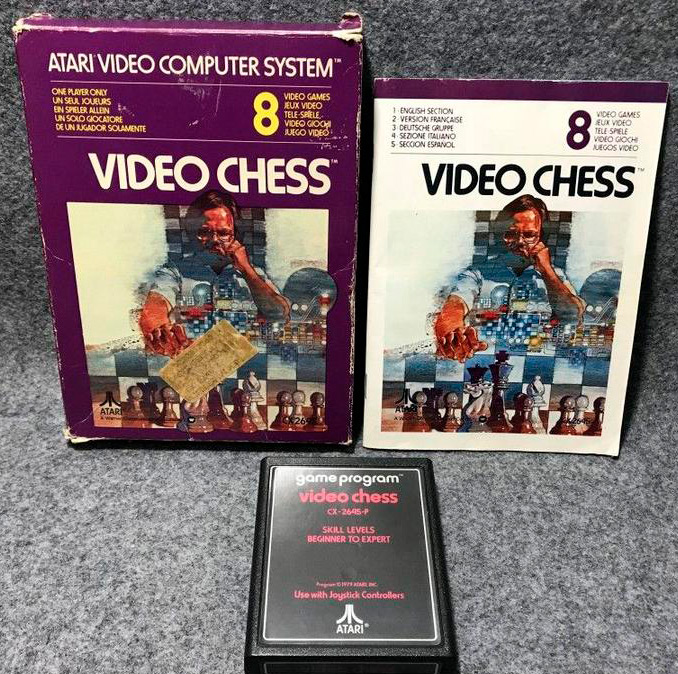
“When the SCV was first manufactured,” recalls Mr. Kaplan, “the box had a chess piece. Those marketing guys… Let’s go”we said, “you will never be able to play chess” Well, some guy from Florida sued us because there was a chess piece on the cover and we didn’t have a chess set“.
A year later, Atari designers began developing Chess. “The boys were playing”, remembers Allan Alcorn, then head of engineering at Atari,” and one of them said, “I can write an algorithm, but I can’t get a playing field on the screen” Another said, “That’s easy,” Larry Wagner wrote the algorithm; he took him two years with the help of the national chess champion Julio Kaplan. Mr. Whitehead made the screen in two days, developing the trick now known as Venetian blinds.
To display eight chess pieces on the screen (instead of the maximum six possible with triple copies), Mr. Whitehead showed each object on every other scan line. On the first sweep of the screen, the graphics for four objects were displayed; on the next scan, the graphs of the other four were displayed. The gaps were obvious, but the chess pieces were recognizable.
Although primitive compared to today’s chess machines, the Wagner-Whitehead chess set, which used 4 kilobytes of ROM and 138 bytes of random access memory, it was as good as the chess machines on the market at the time. There was only one problem: the TV screen was displaying random colors while the Atari Video Computer System (VCS) calculated the next move; there was no processor time left for the screen.
The Venetian technique has appeared in many games since Chess. It was used for the horses in Polo, a Carol Shaw game that never came out, and in Basic Programming to get 12 characters on one line. It was also used in Stampede, by Mr. Whitehead, to animate the legs of animals, and more recently, in Sky Jinks, also by Mr. Whitehead, where parts of the balloon baskets appear in alternating lines. Used subtly, Mr. Whitehead noted, the technique is barely noticeable.
Having exploited variations in player graphics, the programmers turned to other areas of the Stella chip for tricks. One of the first discoveries was that they could write the playing field (a low-res 40-bit background) on the fly.. Al Miller did it in Surround, where each block in a 40 by 24 grid can be turned on or off independently. The technique was used by Mr. Whitehead in ChopperCommand to create an additional object for the player: the helicopter that he commands.
Mr. Kaplan first rewrote color on the fly, changing the color line by line to get a figure in his bowling set that has a flesh-colored head, a blue shirt, gray pants, and black shoes. That technique was taken up in Superman to make the cartoon hero’s suit red and blue, and is used extensively for display brightly colored alien attackersas well as settings that seem to recede as the colors deepen, including sunsets and oceans with rolling waves.
Mr. Whitehead noted that once the game is out on the market, any new tricks used are obvious to experienced programmers. This thesis was confirmed by Spectrum’s discovery that two techniques considered trade secrets by Activision at the time of writing were widely known and, in fact, used by designers at other video game companies.
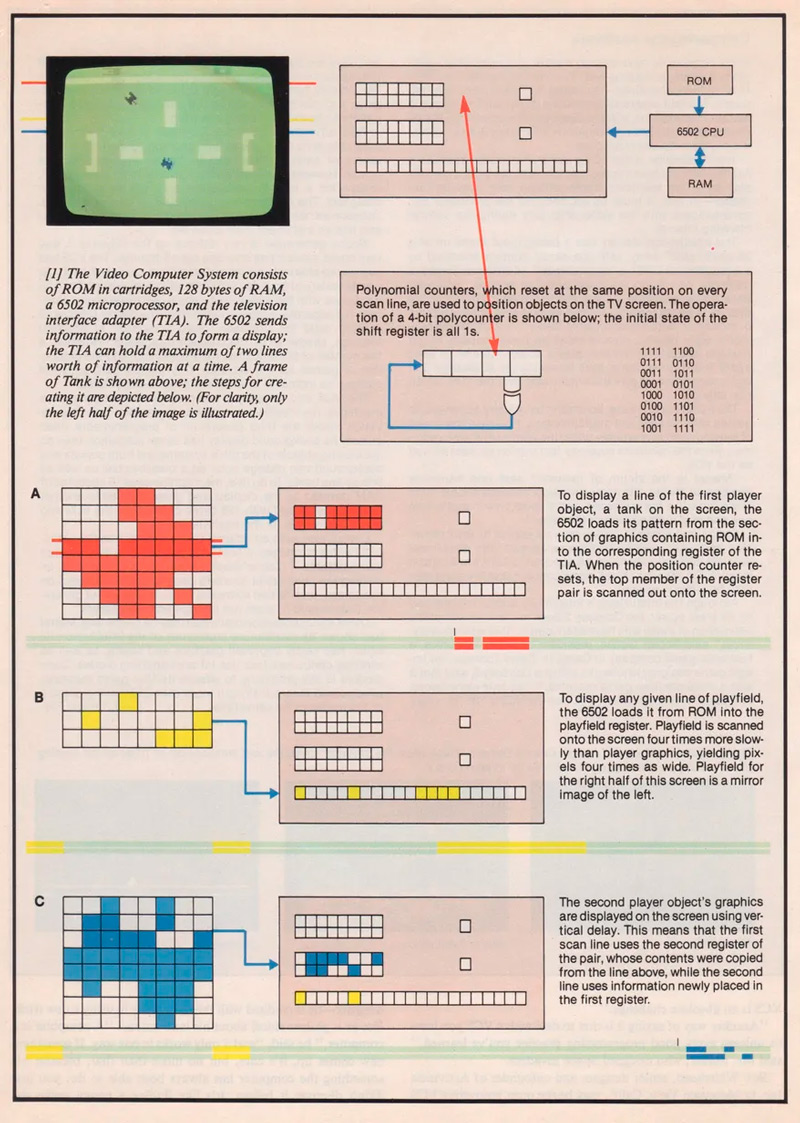
objects that change size
One of the hacks pointed out by the designers exploits the VCS’s ability to display an object at normal, double, or quad width, depending on the player’s log scan speed. The trick is to resize the player object on the fly. At Mr. Whitehead’s Boxing, the game in which this technique is believed to have been first used, a change in the player’s size extends the boxer’s arm in a punch. Mr. Whitehead also used the technique in Skiing, and Imagic’s Brad Stewart has included the trick in his most recent game, Sky Patrol.
Another cheat first appeared in the Dragster game. Designer David Crane, known in the industry as “a coding machine,” wrote an entire kernel on the fly. The code, of course, doesn’t physically move, but instead shifts in time, so that the program is no longer in sync with the TV, and what would otherwise be a static screen scrolls horizontally. When Dragster first appeared, the trick was considered impossible to repeat, but it is now understood throughout the industry. One of the designers using it is Bob Smith from Imagic in the Dragonfire game.
Perhaps the ultimate gimmick is being marketed by a company called Starpath., of Santa Clara, California: a 6-kilobyte RAM module that fits into the VCS instead of a cartridge and accepts cassette tape software. (This option had been considered for the original VCS, but was dropped.) Expanded RAM allows programmers to use graphical tricks that would not fit in the 128 bytes of the VCS: Finest resolution and sophisticated on-the-fly rewrite techniques.
Adding RAM to the VCS is not easy, it is not making cartridges with more than 4 kilobytes of memory. To save money, Atari limited the cartridge connector to 24 pins, omitting the read-write and clock lines for RAM.as well as lines for addresses greater than 4096. Mr. Miner and Mr. Decuir agreed that this decision was a mistake, since a 30-pin connector would have cost only 50 cents for each Atari Video Computer System (VCS) and 10 cents per cartridge and would have allowed both RAM and 64 kilobyte address space.
Nowadays, many companies use 8 kilobyte cartridges using a technique called bank switching, in which reading a certain address triggers a flip-flop, directing all subsequent addresses to a different section of memory. The first bank-switching cartridge was a 6-kilobyte chess set created by Larry Wagner; Bob Whitehead “shrunk” it down to 4 kilobytes, eliminating the need for bank switching, before shipping it.
RAM on cartridges is made possible by resynthesising the clock signals for the RAM from the sync lines leading to the cartridge port. The increased speed of instructions dealing with the first 256 bytes of memory by the 6502 is all that the VCS makes possible., so it uses similar techniques internally to conserve address space. A read call and a write call to the same address can deal with two entirely different registers, Mr. Miner noted: the read-write line is actually being used as another address line, in addition to its intended purpose.
How to make the hardware work?
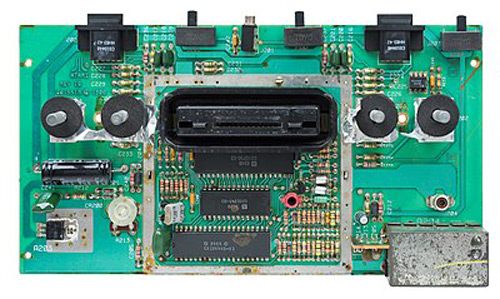
Sometimes it seems that the design of the VCS offers almost unlimited possibilities to programmers. But the basic design of the machine was not easy. MOS tracing was done directly on the screen of an automated integrated circuit drawing system, and circuit analysis was done without sophisticated tools. Mr. Miner remembered simply counting the maximum number of gate delays on any line, the delays of the lines were added and multiplied by two to obtain a safety factor. The first silicon pass failed, he noted, because “there was a line that didn’t go into the flip-flop that I thought; it went around it through 12 more gates. It was twice as many gates as any other line.”
The production of the VCS was also almost a nightmareaccording to those involved. For example, the mechanical design specified two sizes of self-tapping screw, and few workers on the production line could distinguish between the two. If the wrong screw was used, countless metal filings would come out and wreak havoc on the internal circuitry. Also, when the unassembled boxes were stored for a while, the plastic would warp and the two halves would no longer fit together. Production workers learned the “VCS karate chop” to tie the boxes together.
market acceptance
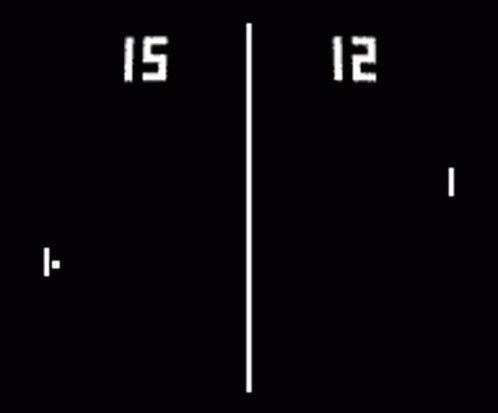
Although Atari was late in delivering the VCS to retailers for the 1977 Christmas season, its sales volume went from 60 to 120 million dollars that year. Still, the company lost money. In 1978 Atari decided to make 800,000 Atari Video Computer System (VCS) machines, more than double that of the previous year. A total of 500,000 orders came in by the end of the summer and, following fall shipments, they disappeared from retail shelves within weeks. But few additional orders came in, and Atari was left with 300,000 unsold machines; the company had doubled its sales volume for the second year in a row, recalls Mr. Decuir, and still lost money.
Warner Communications Inc. of New York had bought Atari for $28 million in 1976., largely due to the expectations of the VCS. But “for two years,” recalls Mr. Mayer, “Atari managed to single-handedly drag down Warner’s stock performance by a significant amount.” Today, thanks in no small part to the success of the VCS, Atari is responsible of more than half of Warner’s total profits.
The lords Mayer, Milner, Miner and Decuir they set out to make a simple consumer product that would sell for two or three years, little more than a dedicated game. By creating a machine with an elegant architecture that left all of its inner workings at the programmer’s fingertips, they ended up (like the first phonograph makers) creating an industry, which today has more than 70 companies vying for a piece of the music software market. video game, estimated this year at 2.4 billion dollars.
Video games and consoles